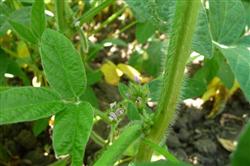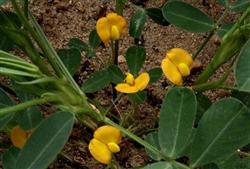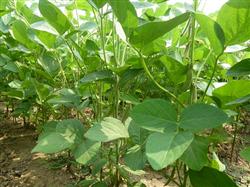Soybean cultivation: the cause of falling flowers and pods of soybean?

The reason for the falling flowers and pods of soybeans? Please introduce and guide the prevention and control methods of soybean falling flowers and pods, the main factors are: 1, poor ventilation and light transmission; excessive planting density, poor planting technology, resulting in excessive growth, premature closure, deterioration of light conditions in the lower part of the plant, resulting in yellowing and shedding of leaves, less nutrition production and accumulation, resulting in flower and pod shedding. 2. Imbalance of nutrient supply: the flower and pod stage of soybean needs the most nutrients, and a large number of flowers and pods will fall off if the nutrient supply is insufficient or maladjusted. 3. Unreasonable water supply: soybean had too little water at flowering and pod stage, the plant wilted, the soil nutrient absorption decreased, and the imbalance of water and nutrient metabolism caused a large number of flowers and pods to fall off. However, too much water decreased the soil temperature, increased the humidity, shaded the field, weakened the light and effect, affected the synthesis and transport of organic nutrients, and increased the shedding of flowers and pods. 4. Disease and pest damage: destroy plant leaves, reduce light and intensity, reduce the production and distribution of nutrients, resulting in flower and pod shedding. Control methods of soybean falling flowers and pods: 1. Reasonable close planting is the central link to coordinate the contradiction between individual and population, make full use of soil fertility and light energy, and obtain high yield of soybean. 2. Reasonable close planting can fully develop the population per unit area, reach the highest degree of light energy utilization and land utilization, and obtain high yield due to the increase of pod number, grain number and grain weight per unit area. The specific density should be determined according to soil fertility, water conservancy conditions and variety characteristics, generally between 10, 000 and 20, 000. 2. Skillfully topdressing fertilizer needs a lot of nutrients in the flowering and podding stage, and the application of base fertilizer and seed fertilizer alone can not meet the demand. Therefore, topdressing in the early flowering stage, especially in barren land, the seedling development is weak, and the fields that can not be closed in time should be topdressing 8-10 kg urea per mu. You can also spray fertilizer outside the root, spraying 0.3% potassium dihydrogen phosphate solution 60-70 kg per mu, or using 50 kg water and 20-25 g ammonium molybdate to make a solution, foliar spraying, the effect is particularly significant. 3. The flowering and podding period of timely irrigation and drainage is not only the most exuberant period of vegetative growth and reproductive growth, but also the critical period of water demand. Lack of water seriously affects transpiration and photosynthesis, which will cause a large number of young pods to fall off. When the growth of soybean is slow, the leaves are old and green, and the leaves wilt at noon, that is, the soybean is short of water, so it should be irrigated in time. If there is stagnant water in the field after heavy rain, it should be eliminated in time to prevent waterlogging. 4. To prevent overgrowth due to good water and fertilizer conditions, high density, long branches and leaves, and closed fields. In this regard, to be controlled, 15% paclobutrazol can be sprayed with 40 grams of paclobutrazol and 60 kilograms of water. 0.2% Dwarf can also be sprayed to inhibit overgrowth. 5. The main disease of soybean harmed by diseases and pests is leaf spot. In the early stage of disease and pod formation, 80-1000-fold solution of 70% methyl thiophanate wettable powder or 50% carbendazim wettable powder were sprayed and controlled. The main pests are soybean heart borer, bean pod borer, soybean aphid and so on, which can be controlled by insecticide spray to reduce the drop of flowers and pods caused by diseases and pests. Click to get more soybean planting technology click to get more grain and oil crop planting technology
- Prev

Peanut planting technology: what is the use of applying calcium fertilizer to peanuts?
What's the use of applying calcium fertilizer to peanuts? Ask netizens to help introduce the reasons why peanuts apply calcium fertilizer: peanuts are calcium-loving crops (it is determined that for every 100 kg of peanut pods, 2.7 kg of calcium is needed). Calcium is needed when seeds germinate; calcium can strengthen nitrogen metabolism in plants.
- Next

Soybean cultivation: what is the use of picking the heart of soybean?
What's the use of picking soybeans? Do you have any netizens to help introduce you? The reason for soybean heart picking: if the soil fertility of soybean is too high, the conditions of water and fertilizer are sufficient, or when it is rainy in the later stage of growth, it is easy to grow. Especially the varieties with infinite podding habits and intercropping soybean are more prominent, once the occurrence of soybean.
Related
- The first cup of black tea in spring, the flavor and history of tea gardens in Kenya, Africa
- The computer can not only choose potatoes, but also grow tea rice. AI will grow winter oolong tea champion.
- It is not only the inflated tea bitten by insects, but also engraved with the four seasons tea in Beipu.
- The Oriental Beauty Tea Festival in Zhuxian County takes the stage at the weekend to experience the plus-size feast of oil tea.
- & quot; Oriental Beauty Tea & Exploration of Emei in Hsinchu, the hometown of quot;
- The new variety of strawberry "Tainong 1" dessert is the first choice with mellow aroma. Crimson gorgeous
- History of Tea in Taiwan: from Wild Inner Mountain to Export Tea Garden
- Two types of Taiwan Oriental Beauty Black Tea won the British three-Star Award for Childhood Tea Xiang Zhang Jiaqi changed from pilot to champion tea maker.
- Banana species and varieties: the planting history of Taiwan Xianren banana and dwarf banana is long, is banana disease resistant?
- Coffee planting Technology: Qianjie Coffee from Seedling to harvesting

